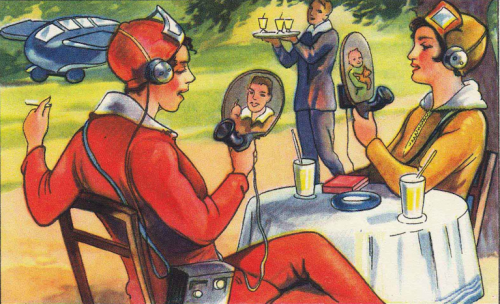
Collectible trading cards, portraying the future, from 1930 Germany.
(via Ace)
Some other predictions about the future…
From France in 1910
From Germany circa 1900
From Seagram’s (!) in the mid-1940s
From Ladies’ Home Journal in 1900
Some Chicago Boyz know each other from student days at the University of Chicago. Others are Chicago boys in spirit. The blog name is also intended as a good-humored gesture of admiration for distinguished Chicago School economists and fellow travelers.

Collectible trading cards, portraying the future, from 1930 Germany.
(via Ace)
Some other predictions about the future…
From France in 1910
From Germany circa 1900
From Seagram’s (!) in the mid-1940s
From Ladies’ Home Journal in 1900
The career field in which I served for twenty years was a small one, and one with some inherent peculiarities, one of which was possession at radio detachments of a library of pop music intended for broadcast on AFRTS channels. One of those things which was instilled in broadcast field recruits early on in our training was that no one of any higher rank (or degree of inebriation, often the case) was permitted to remove recordings from our library for personal amusement. Many were the tales of duty E-2s or E-3s refusing such orders from senior officers, who were operating under the (often alcohol-inspired) delusion that the AFRS library operated on the same basis as the local base library. This often happened late at night when the most junior staffers were on duty. That was an order that we had to and would refuse, no matter the rank, and degree of inebriation of the commander demanding it. In that, we could count on the complete backing of our broadcast command, especially when they were informed of it, sometime the following morning. No one, not even (according to some legends, the base or wing commander) was allowed access to the AFRTS library, much less to remove elements of it from the custody of the AFRTS outlet, even if that only custodian was a lowly first-hitch enlisted.
The Presidency of Teddy Roosevelt is often considered the beginning of “The American Century.” The Great White Fleet circled the world. The US defeated Spain in the Spanish American War, probably instigated by the US as it fought to “free” Cuba and the Philippines “fell” into our Empire. Our iron and steel production had surpassed that of Europe. Problems began in 1912 when leading “Progressive” Woodrow Wilson was elected President. This came about as Teddy Roosevelt, for reasons that were not clear, opposed his own successor, William Howard Taft. Roosevelt formed his “Bull Moose” party and divided the vote, electing Wilson. In 1916, Wilson was re-elected, promising to keep us out of World War I. In 1917, following Germany’s decision to wage unrestricted submarine warfare, Wilson declared war on Germany, thus disclosing his lie.
America entered the war in 1917 at the cost of 53,000 lives lost. The intervention probably led to the 1918 Armistice and the Treaty of Versailles, which French Marshall Foch called (accurately) “an armistice for 20 years.” Wilson’s Progressive rule included many similarities to Fascism that would be come more apparent in years to come. Harding and Coolidge were elected in 1920 and reversed many of Wilson’s policies. The next 9 years were marked by prosperity and a surge of innovation. The German war debts, plus those of the allies, put pressure on the international economic system, which resulted in the 1929 panic and elected Franklin Roosevelt in 1932 as Herbert Hoover’s attempts to cope with the 1929 crash failed. Roosevelt campaigned on a platform of a “balanced budget,” which was quickly abandoned once elected. Roosevelt’s experimentation with the economy produced no better results until World War II provided the stimulus to spending plus the absorption of millions of unemployed and an economic boom followed. The cost of this war was 407,000 American lives but it left us with the only undamaged industrial system in the world. A real Boom followed until Lyndon Johnson got us involved in the Vietnam War plus The Great Society, both of which brought us close to financial ruin.
This column is adapted from a recent e-mail from Ryan Crierie that is reposted here with his permission. It is the tale of how almost everything that could go wrong, did go wrong, on the day Nagasaki was nuked.
This is a U.S. military map of the radioactive fall out caused by the nuclear strike on Nagasaki. See the pattern of black dots upper right.
And make sure to read through the P.S. There is a historical “What If” stinger waiting for you there.
Seventy five years ago today the B-29 Enola Gay dropped the Little Boy gun-type atomic bomb on the Japanese city of Hiroshima. Between 80,000 and 100,000 people died, sources vary.
It has been a now 11 year and counting tradition of the Chicagoboyz blog to commemorate this bombing and the events immediately after. Today’s post will speak of the anniversary and share forgotten history from before & after the event. Per the wikipedia article:
The bomb was dropped by the Boeing B-29 Superfortress Enola Gay piloted by Colonel Paul W. Tibbets, Jr., commander of the 509th Composite Group of the United States Army Air Forces and Captain Robert A. Lewis. It exploded with an energy of approximately 15 kilotons of TNT (63 TJ) and caused widespread death and destruction throughout the city.
This act set in motion historical events that lead to the surrender of Imperial Japan, the start of the nuclear age and the Cold War with the Soviet Union that ended in 1989. Yet for all of the event’s importance we, seventy six years, on know less about it’s real history than the myths that arose in Cold War propaganda afterwards.

The fully restored in 2003 B-29 Enola Gay at the National Air and Space Museum’s Steven F. Udvar-Hazy Center